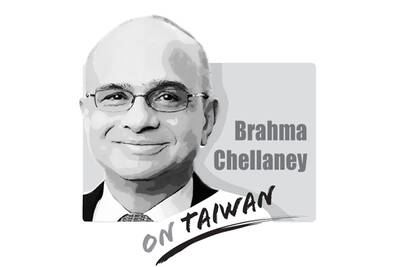The business of constitutional reform is very much colored by the political calculations of the major political parties, and the pan-blue and pan-green camps have been busy keeping each other in check. The so-called “third force,” riding on the crest of Taipei Mayor Ko Wen-je’s (柯文哲) electoral victory, presents itself as non-partisan, as if the third way were the only truly pure and simple force in politics remaining.
The point is politics would not be politics without political calculations. The problems arise when calculating the interests of individuals or political parties, and conforming to the thrust of majority public opinion. Whether the vision of an individual or the political tactics and strategy of a political party is successful, depends on the public and what it chooses to lend its support to.
Democratic politics has individuals competing against each other, and it also has groups fighting it out between themselves. Individuals have limited power and tend to join forces with others with similar ideas and viewpoints to form a political party. Small parties tend to be at a disadvantage in making their voice heard and will often seek out the major parties that share their ideas, merging with them or creating political alliances. How this power is negotiated, consolidated and allocated are all political calculations.
That the third force accuses the blue and green camps of engaging in political calculations is, in itself, a political calculation. It has selected not to join the two major parties and prefers instead to remain independent in its participation in constitutional amendments and elections, and to this end has to clamor against both the blue and the green camps to secure for itself a raison d’etre. It refuses to identify the merits or demerits of constitutional reform promoted by either party, and for this reason has become just as bad as the parties it complains about. It is all about political calculations designed to obtain power for itself.
The third force, which came into being in the wake of student and civic movements, characterized itself as part of their overall success, as all were seeking a shared goal, expressing the same objections, acting en masse. Now it is vying in the elections so it can get seats, and it cannot avoid having its own political calculations, combining its forces.
The third force’s position on reform had, in the past, been similar to, and was supportive of, that of the Democratic Progressive Party (DPP). There was no love lost between this force and the Chinese Nationalist Party (KMT), which it saw as a conservative force blocking reform in the legislature for decades. However, the third force is suddenly casting the DPP in the same light as the KMT, which is unfair and clearly done out of political calculations.
The DPP is now considering whether to stand aside in 13 electoral districts to give room for the third force, hoping this would help it prevent the KMT from keeping its majority in the legislature. Naturally, this is a political calculation placing the big picture before the DPP’s own immediate advantage. Is not defeating KMT candidates with the votes for the third force on top of the DPP’s organized vote just another political calculation?
James Wang is a media commentator.
Translated by Paul Cooper

As strategic tensions escalate across the vast Indo-Pacific region, Taiwan has emerged as more than a potential flashpoint. It is the fulcrum upon which the credibility of the evolving American-led strategy of integrated deterrence now rests. How the US and regional powers like Japan respond to Taiwan’s defense, and how credible the deterrent against Chinese aggression proves to be, will profoundly shape the Indo-Pacific security architecture for years to come. A successful defense of Taiwan through strengthened deterrence in the Indo-Pacific would enhance the credibility of the US-led alliance system and underpin America’s global preeminence, while a failure of integrated deterrence would
It is being said every second day: The ongoing recall campaign in Taiwan — where citizens are trying to collect enough signatures to trigger re-elections for a number of Chinese Nationalist Party (KMT) legislators — is orchestrated by the Democratic Progressive Party (DPP), or even President William Lai (賴清德) himself. The KMT makes the claim, and foreign media and analysts repeat it. However, they never show any proof — because there is not any. It is alarming how easily academics, journalists and experts toss around claims that amount to accusing a democratic government of conspiracy — without a shred of evidence. These
Taiwan is confronting escalating threats from its behemoth neighbor. Last month, the Chinese People’s Liberation Army conducted live-fire drills in the East China Sea, practicing blockades and precision strikes on simulated targets, while its escalating cyberattacks targeting government, financial and telecommunication systems threaten to disrupt Taiwan’s digital infrastructure. The mounting geopolitical pressure underscores Taiwan’s need to strengthen its defense capabilities to deter possible aggression and improve civilian preparedness. The consequences of inadequate preparation have been made all too clear by the tragic situation in Ukraine. Taiwan can build on its successful COVID-19 response, marked by effective planning and execution, to enhance
Since taking office, US President Donald Trump has upheld the core goals of “making America safer, stronger, and more prosperous,” fully implementing an “America first” policy. Countries have responded cautiously to the fresh style and rapid pace of the new Trump administration. The US has prioritized reindustrialization, building a stronger US role in the Indo-Pacific, and countering China’s malicious influence. This has created a high degree of alignment between the interests of Taiwan and the US in security, economics, technology and other spheres. Taiwan must properly understand the Trump administration’s intentions and coordinate, connect and correspond with US strategic goals.